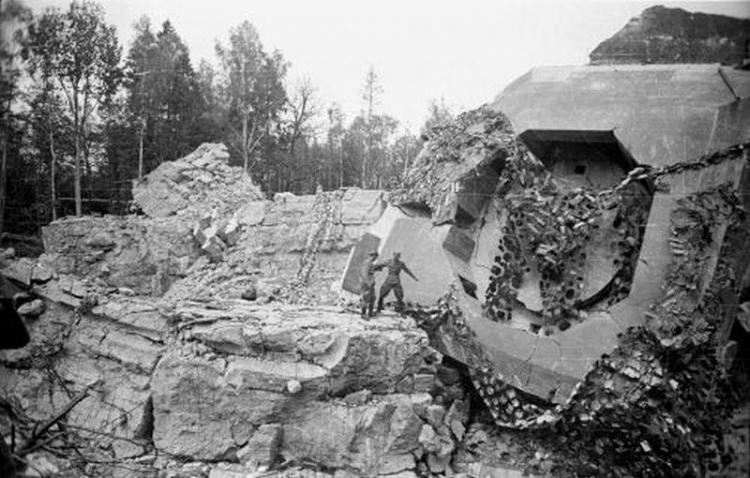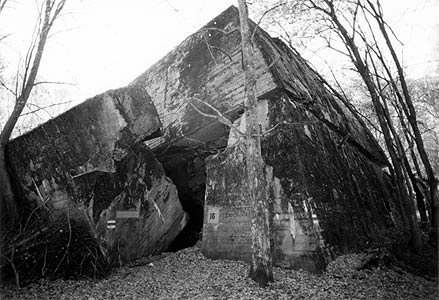Wolf’s Lair demolition and destruction
In October 1944, Red Army troops reached the eastern borders of East Prussia. Therefore, on November 20th, 1944, the headquarters were moved to Zossen near Berlin. Two days later, Field Marshal Wilhelm Keitel ordered the destruction of the Wolfsschanze complex (which has survived to this day in its original version) so that the buildings do not fall into the hands of the enemy and that they do not turn into a fortress, which later the Germans would have to conquer – after all, faith in the “final victory” was still an official slogan. In addition, this plan was part of the “scorched earth” tactics that were widely used during World War II by many armies.
The order of Field Marshal Wilhelm Keitel was carried out on the night of January 24-25, 1945. Entire complex was mined, demolition charges was planted and powerful concrete blocks flew 20-30 meters into the air – and smaller debris up to several hundred. As witnesses testify, as a result of explosions ice cracked on the nearby lakes Moj and Siercze. It is estimated that about eight tons of TNT was used to blow up one bunker.

One of the destroyed heavy bunkers. June 1946 r. Fot. PAP/J. Baranowski
Adolf Hitler‘s bunker suffered the most damage comparing to other heavy bunkers. Almost all other bunkers and shelters – due to the amount of concrete used, wall thickness and solidity of the structure – lasted the demolition. Lighter constructions, barracks and other strategic light buildings were completely destroyed.

From the strategic and military point of view, the execution of Keitel’s order was not entirely successful – we can even say that it was nearly failure. Sapper surpassed the enormity and solidity of buildings, harsh weather conditions, the lack of sufficient explosives and the specter of an approaching opponent. Instead of preventing the complex from becoming a potential stronghold – they end up in exactly opposite situation, yet, ruins of Wolfsschanze were never defended and attacked after the German troops left.
On January 27, 1945, Red Army units entered Hitler’s former war headquarters without a single shot.
Demining of the Wolf’s Lair
On January 27, 1945, the premises of the headquarters were occupied by the troops of the 31st Army of General P. Szafranov, and on February 14, 1945, the NKVD representative at the 3rd Belorussian Front, General Viktor Abakumov, arrived here. Right after that, official demining operation has begun.
The whole area of approx. 15 km² was fenced in two rows of high barbed wire fence, reinforced with additional wire fences. Signal mines were hung on the fences. The space between the 150-m-wide fences on almost the entire perimeter was mined with anti-personnel mines, and in the directions accessible to tanks – with anti-tank mines. Nine types of mines were identified on the site, of which only 4 belonged to typical German weapons. Others were combined mines. S-type mines, Stockmine, Schutzmine, TMi-42 and RMi-43 dominated. The mine density was very high, it was practically impossible for a walker to overcome the 100-130 m lane so as not to step on the mine (until World War II there was no mine field of such density!). The sectors were set up in a mixed system. The mine barrier consisted of anti-personnel and anti-tank mines. Some mines were non-disarming, and the mines in the glass packaging were undetectable by detectors. Because of this, demining was very dangerous, in which fatalities and serious injuries occurred. For these reasons, explosives were used to liquidate the minefield. A complicated mine system was not known, the mines were masked by tall grass, vegetation and bushes.
The 46th battalion of sappers began the first reconnaissance and preliminary work on the demining of Hitler’s former headquarters. In July 1945, on the order of the commander of the 15th Army. Gen. K. Kontryma, company commander Lt. Zdzisław Gruszecki and chor. Łaszkiewicz with a team of sappers recognized the mining of the quarters and potential burial of French prisoners of war in the headquarters (however no graves were found). In 1945, the complex was not demarcated anyway. More important at that time was to check all local crop fields and demining industrial plants. Demining of the minefield (about 10 km long, 80-100 m wide) surrounding the headquarters was done by Polish engineers. In 1954, demining was led by a pre-war officer, later colonel Edmund Józefowicz (1913–1997) from the Masurian Sapper Brigade. At the mine clearance, 46 sapper battalion from Olsztyn in 1946 and 1947 and after a two-year break in 1950-1951, 1 battalion 1 DP from the north and 4 bsap 3 DP from the south and 75 battalion from Giżycko, and in 1952 and 1953 47 battalion from Gdańsk.
In 1952, the 2nd Heavy Brigade of Sappers from Kazuń made fundamental progress in mine clearance. The sapper company Lieutenant Widłak, sent there in the spring of 1952, was to decipher the mine system. When demining the manual section of about 100 m, see. Widłak deciphered the mine system after removing 1100 mines, mostly anti-personnel. The reconnaissance company directed there in autumn and 2 sapper battalion brigades (128 sapper), using this scheme, destroyed almost 13 tons of explosives with 1740 anti-tank and anti-transport mines and 4226 anti-personnel mines. From April 8 to July 4, 1953, the 2nd battalion led the demining, which took over the task of 1 battalion, which conducted work until September 30. The arable lands cleaned in an explosive way in the eastern part of the facility were plowed with a tractor without a tractor driver. 2 CBSap in 1953 removed and destroyed 4,727 “S” mines, 2,850 anti-personnel combined mines weighing 1 kg, 6,255 min anti-transport TMi-42, 6,271 anti-transport mines RMi-43, 1,069 combined anti-personnel mines weighing 4 kg, 437 anti-personnel mines type “Glassmine” and 23 mine alerts. Together, 22832 mines were found and destroyed in 1953. In total, 2 CBSap neutralized over 30,000 mines. During the works, two sappers died in 1952-1953. On September 27, 1953, Brigade Commander Major Piotr Łozicki transferred 48 ha of arable land and 9 ha of meadows to the local authorities in the former Wolf’s Lair. In 1954–1955, the company of battalion 5 BSap and two school platoons under the command of Maj. Gruka. From April 1 to May 10, 5 BSap sappers removed 18 thousand mines. The NCO’s sappers made a clear contribution to the demining operation. The leaders of the demining groups were the school leaders: in 1954, Capt. Władysław Zapłatyński, and in 1955 Lieutenant Cebo. Forest areas around the quarters were mined with so-called jumping mines, which, when activated, were torn apart at a height of about 1 meter, hurting everything in it’s range. Three (3) fuse wires (so-called mustaches) were protruded to the surface (sometimes). The task of the sappers was to determine the place where the mine was buried, discover it, put a TNT cube, connect an electric igniter and detonate. Due to the high danger of this mine type it was not allowed to remove the mine in tradiotional way. This rule was not always followed and one fatal accident occurred. After the demining, some of the sappers were awarded the Crosses of Merit, others were promoted to a higher military rank, and all received the “Meritorious Minesweeper” badge.
The land was handed over after the full demining of the Wolf’s Lair on October 29, 1955. During the demining in 1945–1947 and 1950–1955, sub-unit sappers from seven different units worked. In the years 1953–1955, 54 thousands of mines and approx. 200 thousand of ammunition and artilerry rounds were disarmed. Three sappers were killed.

Mines gathered while demining the Wolf’s Lair. June 1946 r. Fot. PAP – J. Baranowski
Wolf’s Lair demining operation in Polish Film Chronicle (episode 18 from 1946 – about headquarters from 09:03):
We also recommend the material “Earth Returned to Life” (Polish Film Chronicle 51/53), which can be viewed in Repozytorium Cyfrowe. (Unfortunately, the animation is in flash technology, so you need to allow it to play in your browser)
The Polish civilians settling near Kętrzyn after the war used building materials from HQ – often not used during the construction of the Wolf’s Lair – for their own economic purposes. Brick, reinforcing steel, wood paneling, stone blocks, copper and aluminum wires, stoneware pipes and masking mesh were exported from here.
Interesting facts
- Most of the cobblestones located on the pavements and stored in the headquarters were taken away and used to cover Emilii Plater Street and parts of the Palace of Culture and Science in Warsaw
- The wooden barracks not destroyed by the Germans were dismounted and transported to Warsaw, where they initially served as lodging places for the builders of the Palace of Culture and Science – and to this day they function as a student dormitory at Bemowskie Jelonki district (see Google Maps: https://goo.gl/maps/WgXNvN2hXco7JZeYA)
- A large amount of unused concrete (including concrete slabs) and other building materials were used to rebuild the runways at the Warsaw Okecie airport
- Some building materials (including a lot of granite, sandstone and marble) were sent to Warsaw and used to build the so-called House of the Party (then the seat of the Central Committee of PZPR). Today it’s a Warsaw’s Stock Exchange complex.
 English
English polski
polski